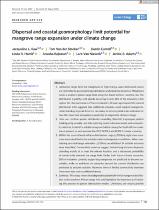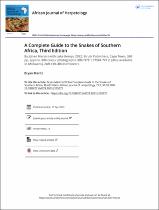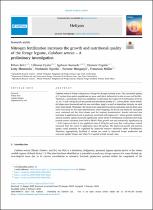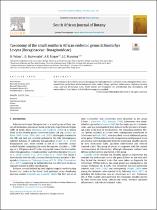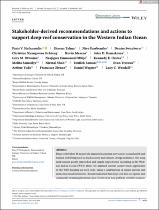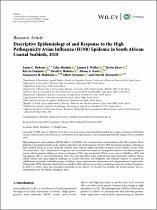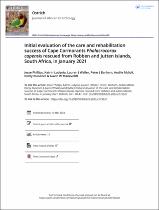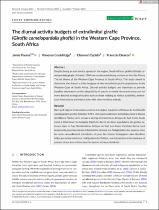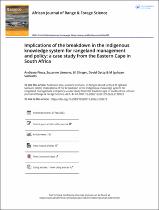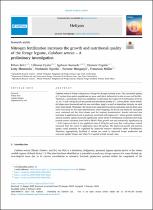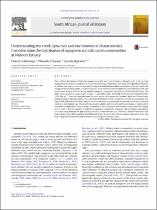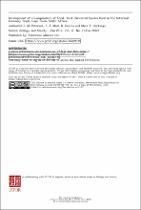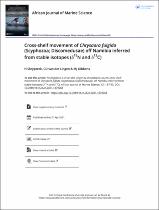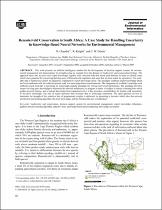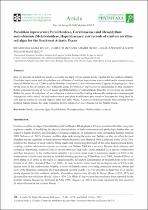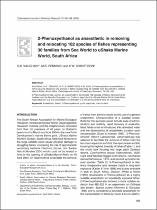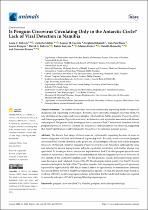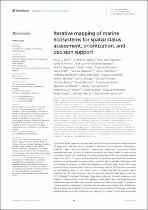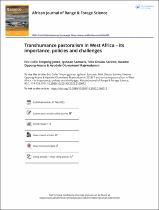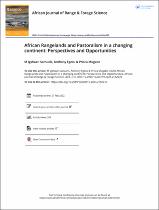Biodiversity & Conservation Biology
Browse by
The department of Biodiversity and Conservation Biology is active in the following research areas: jelly fish; education studies; endangered species conservation; landscape ecology and GIS; marine biology; plant ecophysiology; restoration ecology; sustainable livelihoods; taxonomy and systematics; traditional plant use.
Sub-communities within this community
Collections in this community
Recent Submissions
-
Dispersal and coastal geomorphology limit potential for mangrove range expansion under climate change
(John Wiley and Sons Inc, 2022)Latitudinal range limits for mangroves on high-energy, wave-dominated coasts are controlled by geomorphological features and estuarine dynamics. Mangroves reach a southern global range limit along the South African coastline, ... -
A complete guide to the snakes of Southern Africa
(African Journal of Herpetology, 2023)Background: The new edition of A Complete Guide to the Snakes of Southern Africa represents the third iteration in a series of books that started three decades ago. The latest edition replaces the 2004 edition (Marais ... -
Nitrogen fertilization increases the growth and nutritional quality of the forage legume, calobota sericea – A preliminary investigation
(Heliyon, 2023)Calobota sericea is being evaluated as a forage for drought stressed areas. The nutritional quality of C. sericea from native populations are poor, and this is believed to be due to poor soil fertility. Therefore, a ... -
Taxonomy of the small southern African endemic genus Echiostachys Levyns (Boraginaceae: Boraginoideae)
(South African Journal of Botany, 2023)The small genus Echiostachys Levyns (Boraginaceae: Lithospermeae) is revised. It was segregated from Lobostemon Lehm. on the basis of the herbaceous habit, radical foliage, spiciform inflorescence, slightly accrescent ... -
Stakeholder-derived recommendations and actions to support deep-reef conservation in the Western Indian Ocean
(Wiley, 2022)Deep reefs below 30mprovide essential ecosystem services for ocean health and human well-being such as food security and climate change resilience. Yet, deep reefs remain poorly researched and largely unprotected, including ... -
Descriptive epidemiology of and response to the high pathogenicity avian influenza (h5n8) epidemic in South African coastal seabirds, 2018
(Wiley, 2023)High pathogenicity avian infuenza (HPAI) clade 2.3.4.4b H5N8 virus was detected in coastal seabirds in late 2017 in South Africa, following a devastating epidemic in the commercial poultry and ostrich industries. By May ... -
Initial evaluation of the care and rehabilitation success of Cape Cormorants Phalacrocorax capensis rescued from Robben and Jutten islands, South Africa, in January 2021
(Taylor and Francis Group, 2023)The population of the endangered Cape Cormorant Phalacrocorax capensis more than halved over the last three decades (BirdLife International 2018a). In January 2021, nearly 2 000 Cape Cormorant chicks were ... -
The diurnal activity budgets of extralimital giraffe (Giraffa camelopardalis giraffa) in the Western Cape Province, South Africa
(Wiley, 2023)Despite being an extralimital species in the region, South African giraffes (Giraffa camelopardalis giraffa, Schreber 1784) are continuously being introduced into the Albany Thicket Biome of the Western Cape Province of ... -
Implications of the breakdown in the indigenous knowledge system for rangeland management and policy: A case study from the Eastern Cape in South Africa
(Taylor and Francis Group, 2023)Communal rangelands in South Africa are generally perceived as overgrazed owing to complexities in their histories and collective utilisation which often leads to improper management. A suitable ... -
Nitrogen fertilization increases the growth and nutritional quality of the forage legume, Calobota sericea – A preliminary investigation
(Elsevier, 2023)Calobota sericea is being evaluated as a forage for drought stressed areas. The nutritional quality of C. sericea from native populations are poor, and this is believed to be due to poor soil fertility. Therefore, a ... -
Understanding the creek dynamics and environmental characteristics that determine the distribution of mangrove and salt marsh communities at Nahoon Estuary
(Elsevier, 2016)The southern distributional limit for mangroves on the east coast of Africa is thought to be at the planted mangrove forest at Nahoon Estuary (33° S) in the Eastern Cape, South Africa. This study investigated the influence of ... -
Development of a compendium of local, wild-harvested species used in the informal economy trade, Cape Town, South Africa
(Resilience Alliance, 2012)Wild harvesting has taken place over millennia in Africa. However urbanization and cash economies have effectively altered harvesting from being cultural, traditional, and subsistence activities that are part of a rural ... -
Cross-shelf movement of chrysaora fulgida (scyphozoa; discomedusae) off namibia inferred from stable isotopes (δ15n and δ13c)
(Taylor and Francis Group, 2021)Large and small specimens of two species of metagenic Scyphozoa (true jellyfishes) can be found in nearshore waters off central Namibia throughout the year. Whereas populations of Chrysaora ... -
Renosterveld conservation in South Africa: A case study for handling uncertainty in knowledge-based neural networks for environmental management
(International Society for Environmental Information Sciences, 2009)This work presents an artificial intelligence method for the development of decision support systems for environmental management and demonstrates its strengths using an example from the domain of biodiversity and ... -
Porolithon improcerum (porolithoideae, corallinaceae) and mesophyllum macroblastum (melobesioideae, hapalidiaceae): New records of crustose coralline red algae for the Southwest Atlantic Ocean
(Magnolia Press, 2014)Here we describe in detail two crustose coralline red algal (CCA) species newly reported for the southern Atlantic: Porolithon improcerum and Mesophyllum macroblastum. Porolithon improcerum was recorded on the remote ... -
2-phenoxyethanol as anaesthetic in removing and relocating 102 species of fishes representing 30 families from sea world to uShaka Marine World, South Africa
(AOSIS, 2008)The South African Association for Marine Biological Research, incorporating Sea World, Oceanographic Research Institute and the Dolphinarium relocated from their old premises of 46 years on Durban’s beach front in March ... -
Is penguin circovirus circulating only in the antarctic circle? Lack of viral detection in namibia
(MDPI, 2023)The known host range of circoviruses is continuously expanding because of more intensive diagnostic activities and advanced sequencing tools. Recently, a new circovirus (penguin circovirus (PenCV)) was identified in the ... -
Iterative mapping of marine ecosystems for spatial status assessment, prioritization, and decision support
(Frontiers Media, 2023)South Africa has taken an iterative approach to marine ecosystem mapping over 18 years that has provided a valuable foundation for ecosystem assessment, planning and decision-making, supporting improved ecosystem-based ... -
Transhumance pastoralism in West Africa – its importance, policies and challenges
(African Journal of Range & Forage Science, 2023)The Economic Community of West African States (ECOWAS) recognises transhumance pastoralism as a beneficial livestock production system that can contribute to food security together with economic and political stability. ... -
African rangelands and pastoralism in a changing continent: Perspectives and opportunities
(Taylor and Francis Group, 2023)Eighty-five years ago, Africa was described as a land of promise because it provided an immense opportunity for maximum return in the minimum time (Olaniyan 2000). It was treated this way because ...

